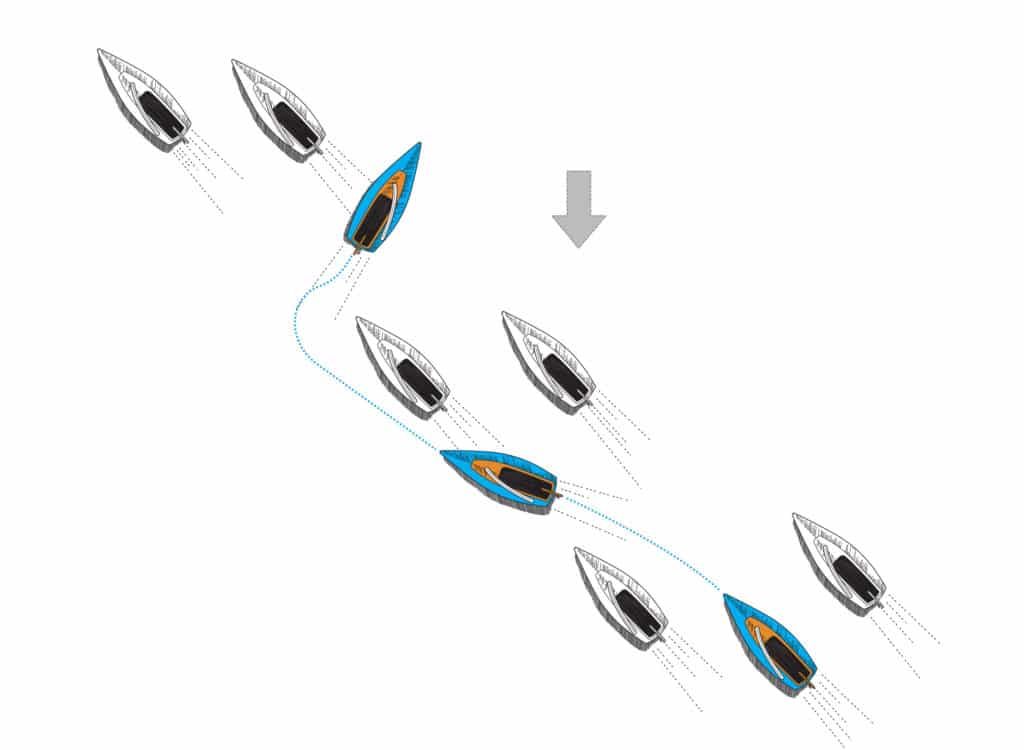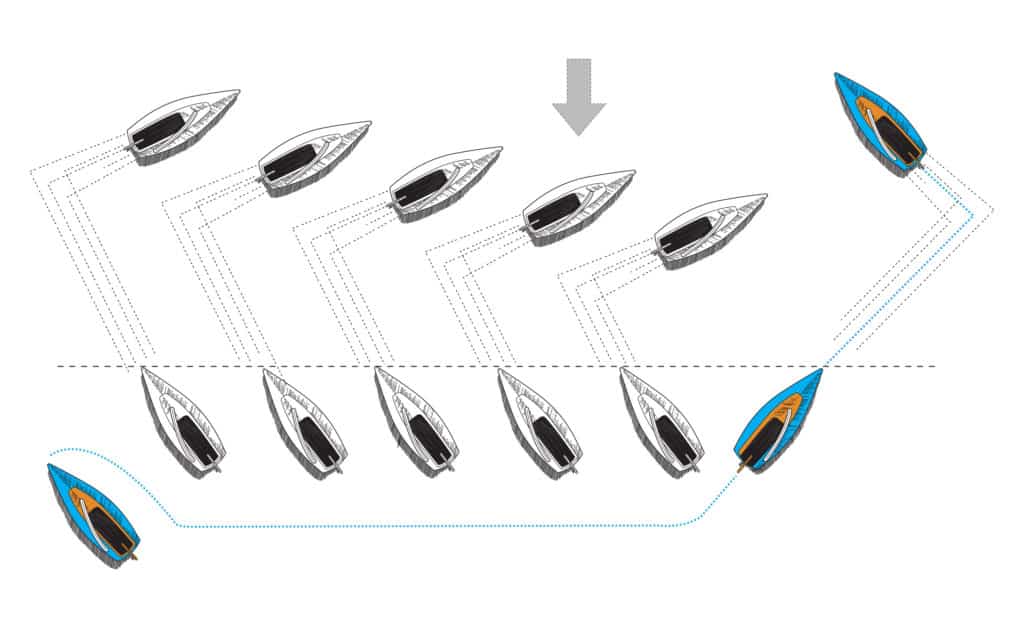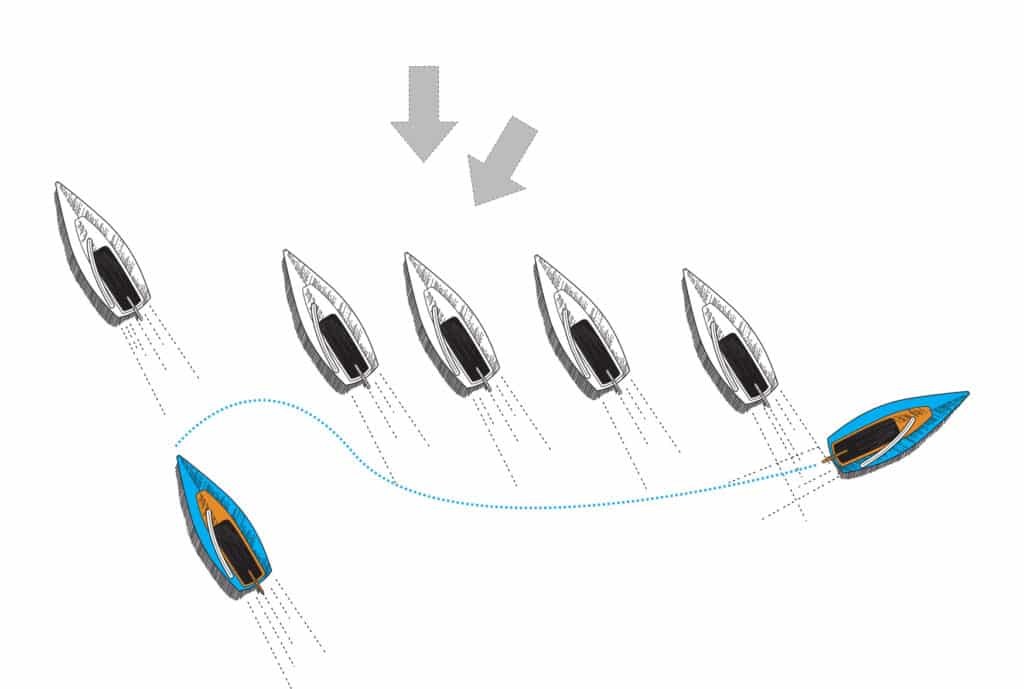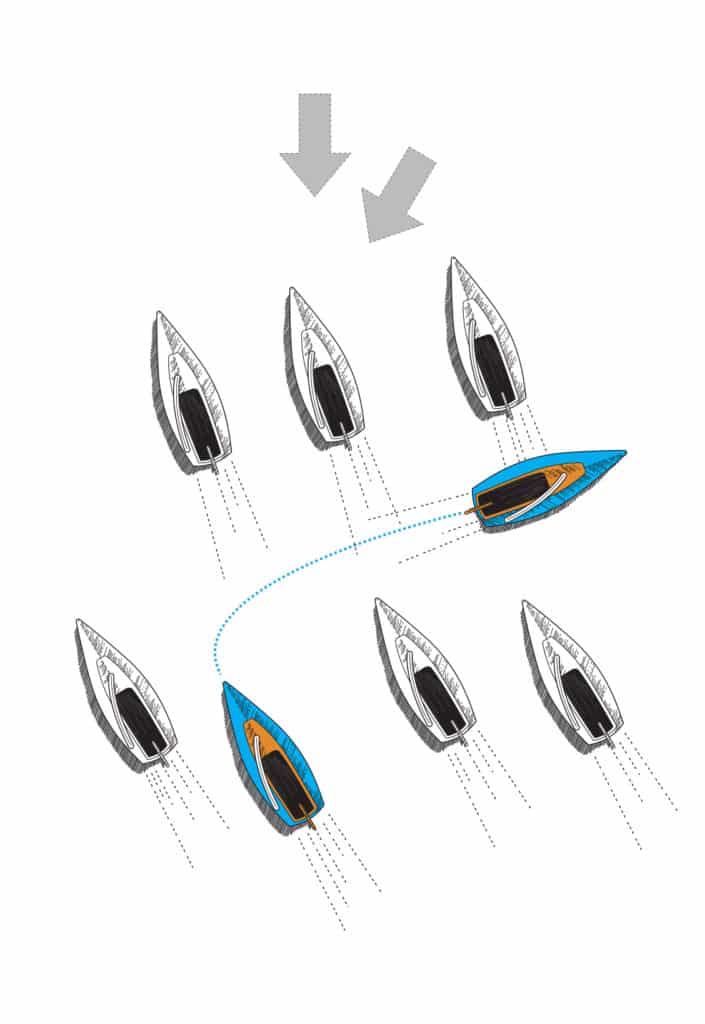
The starting gun goes off. There are a few boats directly ahead, and the disturbed air from those boats is palpable. There are also boats to windward, preventing you from tacking to port without making a huge duck to cross their transoms. Stay here and it’s game over. You need to find a port-tack exit lane, but what’s the best way to get there, and when’s the best time to make your move? From my experience, making your escape ends up being one extreme or the other—tack to port immediately and take your lumps or be patient and wait for opportunities. The middle ground never seems to work well.
Before making any move, be sure you’re sailing as well as possible in the moment. Keep the boat moving, even if you have to ease sails a bit. As long as you only have to do this for 20 seconds or so, you’ll end up in the same spot after your dip, but with more speed (Diagram 1), which you’ll need if someone tacks on you. This also opens up a little space to windward so you won’t have a massive dip, which can be really costly. Don’t make the mistake of pinching; just to try to stay in the lane. If you are going slow and pinching, when you make your move to port, you’ll be starting it with a down-speed tack.

An Early Bail Out
If you’re about to have a bad start, and there’s a hole to weather of you, the escape is to be on port tack before the gun goes off. Tack and just start dipping. The fleet mentality is you must start on starboard tack, so the last guy, up by the committee boat is not looking for a boat that might dip him. Instead, he’s looking forward and to windward, concentrating on accelerating. He’s not ready for someone going full speed on port tack passing behind him. He can’t really tack in that moment and get you. Meanwhile, you’re already the first boat to the right and in clean air (Diagram 2).
In TP52s, when the fleet was pretty small with around six boats, Azzura liked the early port-tack bail out. They were hosed at 30 seconds, so 20 seconds before the start they got on port tack and dipped the entire fleet. At the gun, they were up to speed, with no one around them. By the time they tacked back to starboard, the rest of the fleet was bow-to-bow with them on the first cross, and Azzura had the starboard advantage. Normally, if someone starts just to the right of you, on the same tack, he’ll tack once, you’ll tack over, then he’ll have to tack a second time. A lot of times you can just cross because he’s done two tacks, but if he starts on port tack, he’ll have only done one tack, so the port-tack start can be really powerful.
I saw this at Key West this year as well while sailing with Interlodge, which is a high-stability TP52, but sticky in light air. It was a driftathon in about 5 knots of wind, and we thought we needed to go right, so the plan for the first race was to be on port tack at 2 minutes and reaching. We reached behind everybody and went to the right-hand side of the course. A couple of boats tried to tack with us, but they just died. We had the momentum, didn’t have to pay the price of a tack in five knots, and we won the side.
In smaller fleets, 10 boats or so, an early bail out to port-tack start can work well, but in a fleet of more than 20 boats, it doesn’t work as well because the line can get too crowded. For example, if you have a 50-boat fleet, there will be a bunch of boats fighting for the boat end, and you may not be able to find a hole to go off on port tack. If you’re on port thinking, ‘I’m going to dip that guy at the boat,’ chances are there’s going to be someone who had a bad start at the boat, and now you can’t dip him and cross the line.

The Preemptive Exit
Why tack out early after a bad start? Imagine you’re waiting for someone to the right of you to tack. At some point, you’ll have to bite the bullet and dip that boat. If you dip him right after the start, that boat might be a half boatlength behind the leaders. If you wait 5 minutes—you’re in dirty air and he’s in dirty air—you might end up 10 boatlengths behind the leaders. The idea behind getting out early is that, if you’re a boatlength behind the leaders and have to tack and dip a boat, on a 10-minute beat, you still have 9 minutes and 30 seconds left to catch them. If you wait 5 minutes for that guy to tack out, you will have only 5 minutes left on the beat to catch up. So in this case, waiting really reduces your options and puts you further behind with less time to gain. Here are two scenarios when tacking early will work:
The competition is at the committee boat and lifted, pinning a group of boats to leeward. You can bet they’re thinking, “I’m not tacking.” That’s your sign to tack onto port and get out early (Diagram 3).
The boats lined up to windward are in a comfortable sailing lane and are in a huge lift, which makes it a pretty hard decision for the competition to tack on you. This is a good time to go behind them. Tack out early (Diagram 4).

The Patient Bail Out
The most important reason to wait is you’ll avoid being “ping-ponged” by boats tacking in front of or on top of you. Basically, you’re letting the traffic thin out, which allows you to see the shape of the fleet, and picking the perfect time to escape where fewer boats can tack on you. Look around at how packs of boats are compressing. Suppose a few boats are hipped up close together, to windward and aft. If you see a windward boat in that position, it’s probably going to tack in the next 30 seconds. If you tack, it will likely be right on your wind, so don’t tack. Since they’re going to tack anyway, when they see you coming, it’s just inviting them to wait 10 seconds to really kill you.
Another common scenario is when you get a massive heading windshift, and you think someone’s going to tack on you. Don’t tack right away because you will have given them two reasons to tack. Sail straight, be patient, and wait for them to tack.
It’s almost always better to be patient than looking for the quick exit move. If you’re patient and sail in dirty air for the entire leg, you might lose 10 boatlengths, but if you get ping-ponged around, repeatedly tacking, you’ll lose a lot more than that. Also, if you take the middle route, you’re likely to sail in dirty air and have boats repeatedly tacking on you. Plus, you’ll put yourself in the middle of the beat, where you’ll eventually have to dip a lot of boats coming in from either side. Most people blindly tack out as soon as they see themselves in a difficulty position. Try being patient. You’ll be surprised at how well it works.









